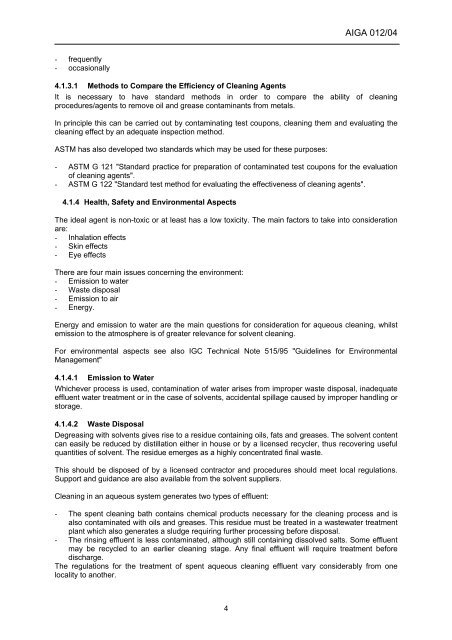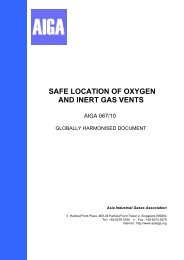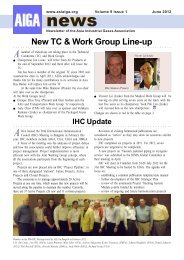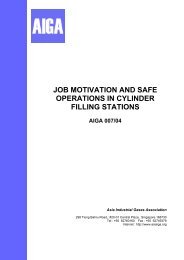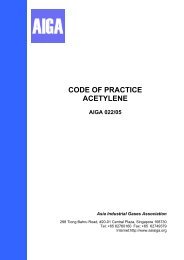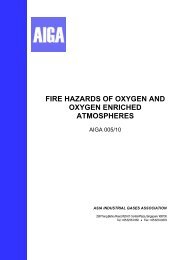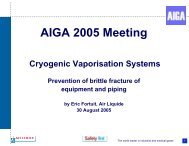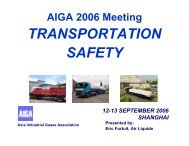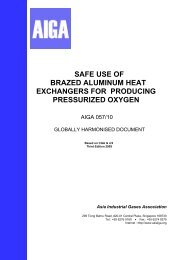CLEANING OF EQUIPMENT FOR OXYGEN SERVICE - AIGA
CLEANING OF EQUIPMENT FOR OXYGEN SERVICE - AIGA
CLEANING OF EQUIPMENT FOR OXYGEN SERVICE - AIGA
You also want an ePaper? Increase the reach of your titles
YUMPU automatically turns print PDFs into web optimized ePapers that Google loves.
- frequently<br />
- occasionally<br />
4<br />
<strong>AIGA</strong> 012/04<br />
4.1.3.1 Methods to Compare the Efficiency of Cleaning Agents<br />
It is necessary to have standard methods in order to compare the ability of cleaning<br />
procedures/agents to remove oil and grease contaminants from metals.<br />
In principle this can be carried out by contaminating test coupons, cleaning them and evaluating the<br />
cleaning effect by an adequate inspection method.<br />
ASTM has also developed two standards which may be used for these purposes:<br />
- ASTM G 121 "Standard practice for preparation of contaminated test coupons for the evaluation<br />
of cleaning agents".<br />
- ASTM G 122 "Standard test method for evaluating the effectiveness of cleaning agents".<br />
4.1.4 Health, Safety and Environmental Aspects<br />
The ideal agent is non-toxic or at least has a low toxicity. The main factors to take into consideration<br />
are:<br />
- Inhalation effects<br />
- Skin effects<br />
- Eye effects<br />
There are four main issues concerning the environment:<br />
- Emission to water<br />
- Waste disposal<br />
- Emission to air<br />
- Energy.<br />
Energy and emission to water are the main questions for consideration for aqueous cleaning, whilst<br />
emission to the atmosphere is of greater relevance for solvent cleaning.<br />
For environmental aspects see also IGC Technical Note 515/95 "Guidelines for Environmental<br />
Management"<br />
4.1.4.1 Emission to Water<br />
Whichever process is used, contamination of water arises from improper waste disposal, inadequate<br />
effluent water treatment or in the case of solvents, accidental spillage caused by improper handling or<br />
storage.<br />
4.1.4.2 Waste Disposal<br />
Degreasing with solvents gives rise to a residue containing oils, fats and greases. The solvent content<br />
can easily be reduced by distillation either in house or by a licensed recycler, thus recovering useful<br />
quantities of solvent. The residue emerges as a highly concentrated final waste.<br />
This should be disposed of by a licensed contractor and procedures should meet local regulations.<br />
Support and guidance are also available from the solvent suppliers.<br />
Cleaning in an aqueous system generates two types of effluent:<br />
- The spent cleaning bath contains chemical products necessary for the cleaning process and is<br />
also contaminated with oils and greases. This residue must be treated in a wastewater treatment<br />
plant which also generates a sludge requiring further processing before disposal.<br />
- The rinsing effluent is less contaminated, although still containing dissolved salts. Some effluent<br />
may be recycled to an earlier cleaning stage. Any final effluent will require treatment before<br />
discharge.<br />
The regulations for the treatment of spent aqueous cleaning effluent vary considerably from one<br />
locality to another.


